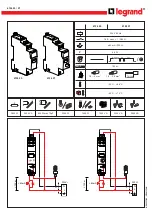
S4 Elements
745
Transformer Management Relay
Se
tpoints
http://www.GEindustrial.com/multilin
5–63
GE Multilin
The 745 implementation of RGF (shown below) is a low impedance current
differential scheme where “spill” current due to CT tolerances is handled via load
bias similar to the percent differential. The 745 calculates the vectorial difference of
the residual and ground currents (i.e. 3
I
0
-
I
g
) and divides this by the maximum line
current (
I
max
) to produce a percent slope value. The slope setting allows the user to
determine the sensitivity of the element based on the class and quality of the CTs
used. Typically no more than 4% overall error due to CT “spill” is assumed for
protection class CTs at nominal load.
FIGURE 5–25: Restricted Ground Fault Implementation
The issue of maloperation due to heavy external faults resulting in CT saturation is
handled by a programmable timer. The timer provides the necessary delay for the
external fault to be cleared by the appropriate external protection with the added
benefit that if the RGF element remains picked up after the timer expires, the 745
operates and clears the fault. This approach provides backup protection. Since the
RGF element is targeted at detecting low magnitude internal winding fault currents,
the time delay for internal faults is of little consequence, since sensitivity and
security are the critical parameters.
For example, consider a transformer with the following specifications:
10 MVA, 33 kV to 11 kV, 10% Impedance, Delta/Wye30
R
g
= 6.3 ohms
Phase CT Ratio = 600 / 1 A
Rated Load Current =
I
rated
= 10 MVA / (
×
11 kV) = 525 A
Maximum Ph-to-Gnd Fault Current =
I
gf(max)
= 11 kV / (
×
6.3) = 1000 A
For a winding fault point at 5% distance from the neutral:
(EQ 5.10)
From FIGURE 5–23: Fault Currents vs. Points from Neutral on page 5–62, we see
that the
I
p
increase due to the fault is negligible and therefore 3
I
o
= 0
(approximately). Therefore, the maximum phase current =
I
max
=
I
rated
= 525 A
(approximately), and
(EQ 5.11)
The Winding 1 Restricted Ground Fault setpoints are described below:
•
W1(3) RESTD GND FAULT PICKUP
: Enter the minimum level of ground
differential current (in units of Phase CT primary associated with the winding,
where the RGF is set) for the Winding 1(3) Restricted Ground Fault element.
•
W1(3) RESTD GND FAULT SLOPE
: Enter a slope percentage (of ground
differential current to maximum line current).
Ia
Ib
Ic
Ig
Timer
0 to 0.5 s
OUTPUT
Calculate
Maximum Phase
Current
Slope = Igd/Imax
Slope > Setpoint
Imax
Igd > Setpoint
AND
Calculate
3I
0
Calculate
|3I – Ig|
0
Measure
Ig
Igd
745 RELAY
3
3
I
fault
0.05
I
gf max
(
)
×
0.05 1000 A
×
50 A
=
=
=
I
gd
3
I
0
I
g
–
0
I
fault
Phase CT Primary
-----------------------------------------------------
–
0 50 A
600
--------------
–
0.08 CT
×
Pickup Setting
=
=
=
=
=
Slope
I
gd
I
max
-------------
50 A
525 A
------------------
9.5% (select Slope Setting = 9%)
=
=
=
Time Delay: dependent on downstream protection coordination (100 ms typical)
Summary of Contents for Multilin 745
Page 2: ......
















































